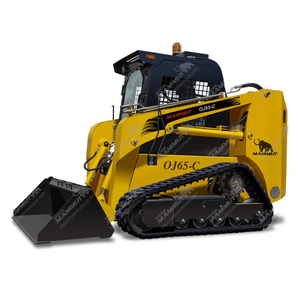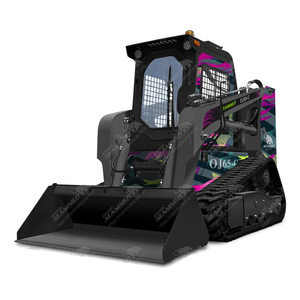(3749 products available)











































































































































































































Cat wheel loaders come in different models based on the general WA600 loader concept. Some of the models below are frequently mentioned in business reports.
Engine:
The WA600 loader features an SAA6D170E-5, six-cylinder, diesel-powered engine with an electronically controlled engine output that ranges from 336 kW to 452 kW. It boasts an impeccable net power output of 373 kW.
Operating capacity:
The WA600-3 operating capacity is 6000 kg, while the WA600-3E0 is at 6800 kg. This signifies the maximum weight of material from the ground that the loader can reliably and safely pick up.
Overall dimensions:
The three-dimensional overall dimensions of the WA600-3 model are 10.555 m, 3.350 m, and 4.175 m, while that of WA600-3E0 is 10.685 m, 3.460 m, and 4.280 m, respectively. The overall dimension varies depending on the model.
Daily Checks:
Users should inspect the wheel loader thoroughly for any signs of leakage, damage, or loose components. They should pay close attention to critical components such as forks or buckets, tires, and steering and hydraulic systems. They should make sure they examine fluid levels for engine oil, hydraulic fluid, coolant, and fuel before operating the wheel loader. Also, ensure the fluid levels are within the specified ranges and top off if necessary. Examine the wheel loader's filters and belts for any signs of wear or clogs, and replace them if necessary.
Weekly Maintenance:
Users should clean the air filter elements and inspect them for any damage on a weekly basis. Conduct a thorough inspection of hydraulic hoses and connections for any signs of wear, leaks, or damage, and address any issues if they arise. For wheel loaders with attachments, ensure the attachment's pins and bolts are greased and properly secured. If the wheel loader operates in extremely dusty or dirty environments, the air intake system may need more frequent inspection and cleaning.
Monthly Care:
Users should check the cooling system components and ensure they perform a thorough cleaning of any debris or dust buildup on a monthly basis, especially on the radiator and condenser. They should inspect the wheel loader's lighting and replace any burned-out bulbs or damaged fixtures. Depending on the model, users may need to inspect the transmission fluid and differential grease levels and top them off if needed.
Quarterly or Semi-Annual:
Users should perform a detailed inspection of the hydraulic system on a semi-annual basis. They should check for any signs of wear, damage, or leaks in hoses, cylinders, and connections. Inspect and adjust the wheel loader's bucket or fork linkage and tilt cylinders, ensuring proper alignment and function. Users should also conduct a thorough inspection of steering linkage components, ensuring that they are properly greased and free of wear or damage. They should replace any loose or worn steering components to maintain optimal handling and control.
Big loaders, such as the WA600-3E0 loader and the WA600-6E0 loader, have very large applications due to their enormous sizes, powerful engines, and high payload capacities. These models are at the higher end of wheel loaders.
In the mining industry, big loaders are widely used to load ore from haulage trucks and strip mine overburden to dump areas or ore processing sites. They also load processed ore onto ships or railway wagons. They are the vital link in the ore extraction process. In quarries, big loaders are used to extract limestone, gravel, marble, granite, or other aggregates. They then crush and grade them as per the market demand.
Big loaders are also at the heart of major infrastructure projects. They are used to move large volumes of soil, rocks, and debris during the excavation phase of construction projects. They are also used to load construction materials such as concrete pipes, precast blocks, and steel girders at construction sites.
Big loaders are also used in the agricultural industry to move large bales of pumps, fertilizers, and harvested crops. Their high capacity and speed have made them indispensable in large-scale farming.
Other industries also use big loaders. For example, they are used to mix raw materials like wood chips in the biofuel industry. They may also be used to transport carcasses in some food processing industries or load palm oil in refineries.
Project Requirements
Once an individual's projects and duties are identified, it is essential to consider the type of work the loader will perform. Take note of the materials to be handled, as well as the weight and size of the materials. According to the project's needs, choose a WA600 model with a suitable operating capacity and bucket size for the specific task at hand.
New Models vs. Used WA600 Loaders
Often, people are faced with the question of whether to go for a new model or a used model. New models typically offer the latest technology, higher fuel efficiency, stronger reliability, and more straightforward maintenance. However, they come at a higher cost. Used models are more affordable but can come with higher maintenance needs and potentially lower reliability.
Technological Additions
A lot of recent WA600 models come equipped with tech additions such as touch-screen technology and onboard systems that enable self-diagnosis. These can go a long way toward simplifying loader operation and maintenance. However, it's essential to choose a model with technology that can be quickly understood and serviced by the existing team.
Q1: How does the Cat WA600 wheel loader monitor and control its fuel consumption?
A1: The WA600 wheel loader controls its fuel consumption by intelligent equipment, which can optimize engine performance, and effective load management practices. Those loaders also have a fuel consumption monitoring system, which can provide data and feedback to the operator to encourage more efficient driving.
Q2: What strategies can be employed to maximize uptime and minimize maintenance of the WA600 loader?
A2: The maintenance of the WA600 loader can be maximized and maintenance minimized by following the maintenance schedule, investing in proactive maintenance, using quality lubricants and filters, monitoring equipment performance, training operators, and keeping operators properly focused on their tasks.
Q3: Can the WA600 loader be used for tasks other than material handling, such as landscaping or demolition?
A3: Yes, the WA600 loader can be used for some tasks other than material handling, such as demolition and landscaping. But to do those tasks easily, certain attachments may be required. The versatility of these loaders allows them to adapt to various activities with additional accessories.
Q4: What are some advanced features or options available for the WA600 loader that can enhance productivity or operator comfort?
A4: Some additional features or options available for the WA600 loader include telematics systems, automatic attachment quick couplers, high-vision cab design, and ride control systems, enhancing operator comfort and productivity.